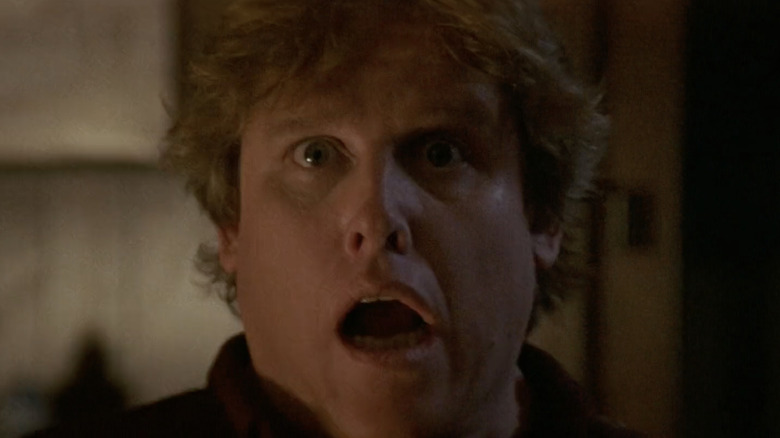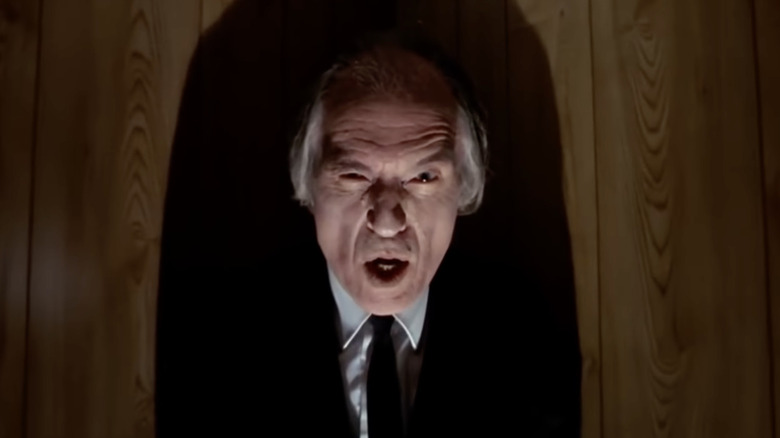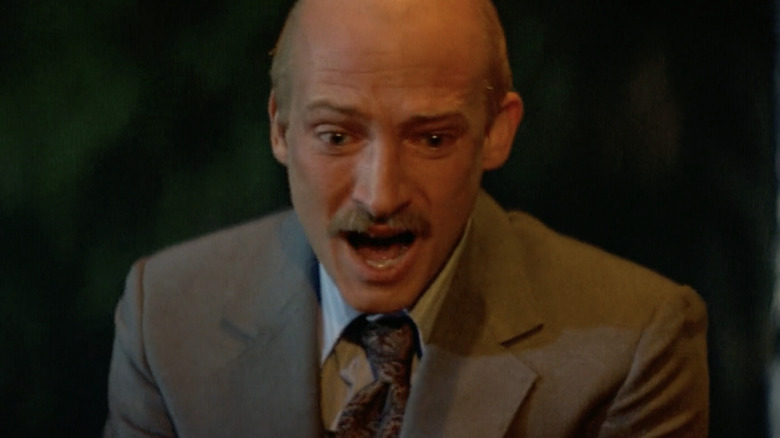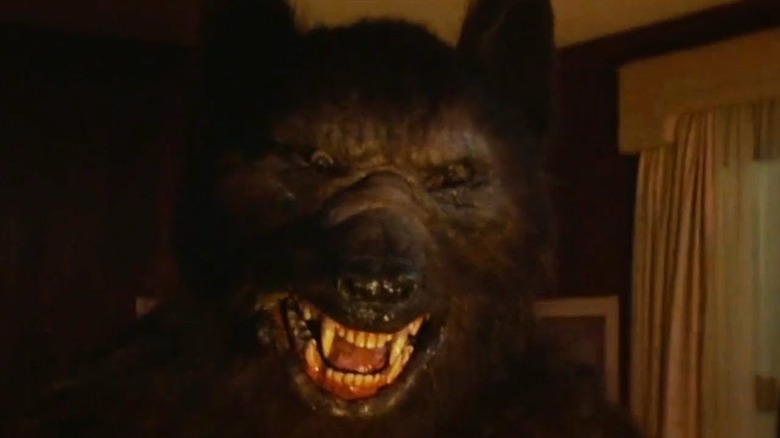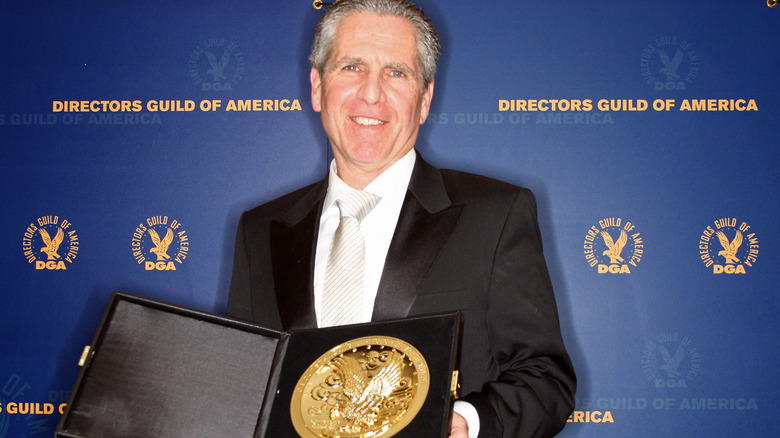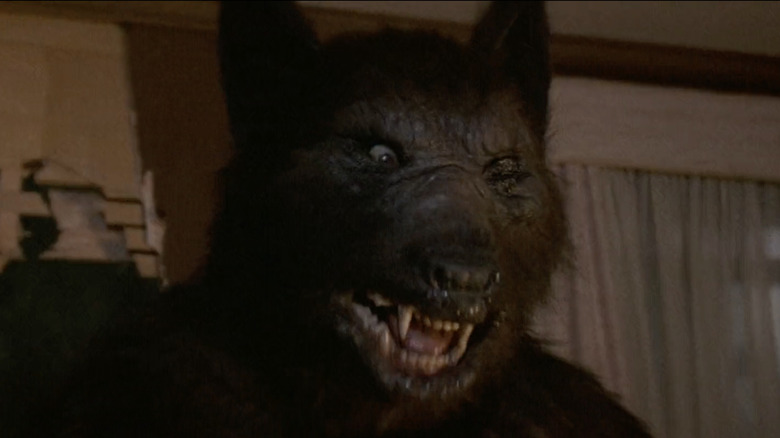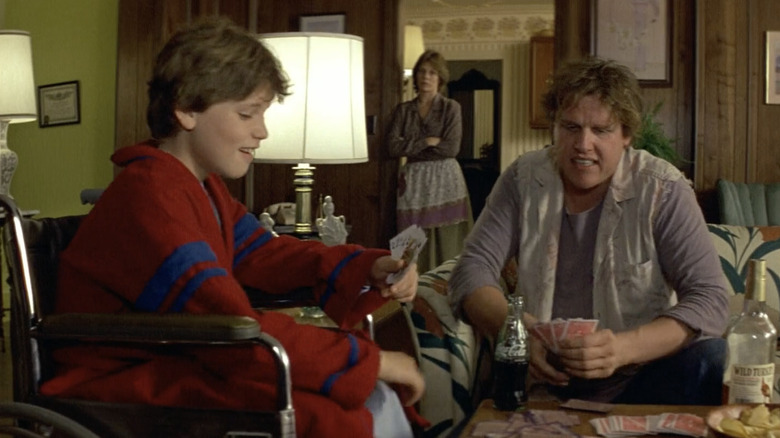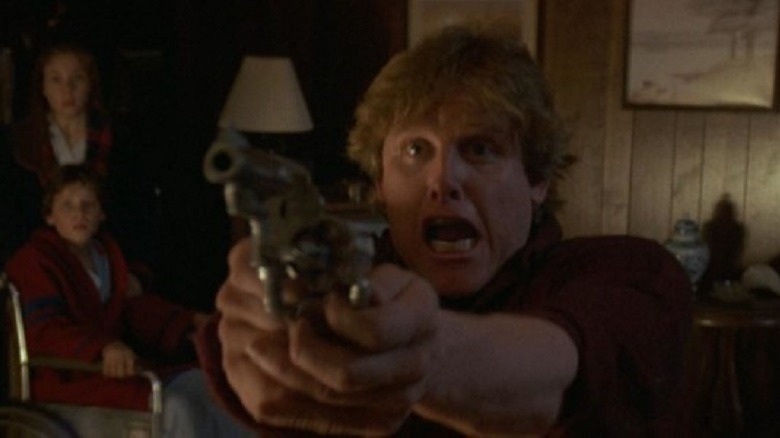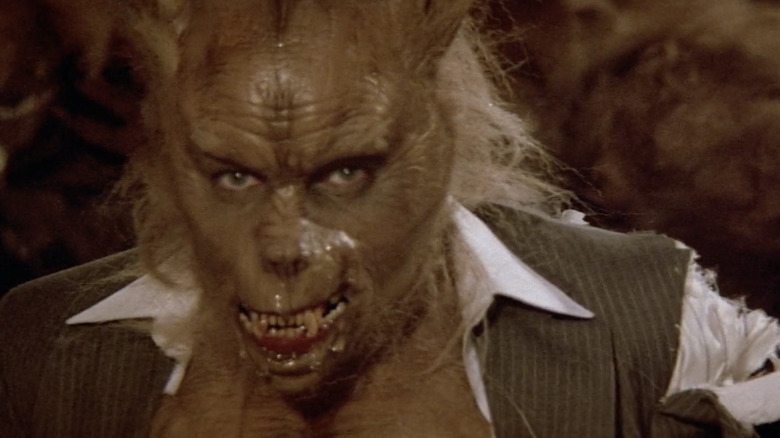Hunt Down These Silver Bullet Details Only Huge Horror Fans Will Know
"Silver Bullet" hardly made a dent in the box office when it opened in theatres in 1985, earning just under $11 million (via The Numbers), and failing to impress critics as well. In spite of that, the film has become something of a cult classic, fondly remembered for its endearing characters, iconic antagonist, and the enjoyable camp that Gary Busey brings to the table.
Based on the Stephen King novella "Cycle of the Werewolf," the film adaptation centers on the residents of the fictional town, Tarker's Mills. This includes paraplegic 10-year-old Marty (Corey Haim), his older sister Jane (Megan Follows), and their adored Uncle Red (Busey), who are haunted by a series of gruesome killings that point to the possibility of a werewolf lurking among the townspeople.
One of the problems critics and audiences had with "Silver Bullet" was its inconsistent tone, which frequently veered between a sincere family drama, a spine-chilling horror, and a Gary Busey camp-fest. Most of the film's issues can be traced to what occurred behind the scenes, including some major disagreements that led to a mid-production change of director. Read on as we reveal important "Silver Bullet" details that shed some light on the infamous monster movie.
Silver Bullet marks one of Stephen King's first screenplay adaptations of his own work
Writing a novel and writing a screenplay are two wholly different things. That could explain why only a handful of authors have been successful in adapting their books into screenplays (via IndieWire). A screenwriter is not afforded the same liberties as a novelist, such as a longer (and rather limitless) duration, multiple points of view (some of which can be omniscient), and the absence of the need to adhere to the language of cinema. Whether Stephen King did justice as a screenwriter — turning his own novella "Cycle of a Werewolf" into a film — is debatable. As well as the mixed reviews it received when it was released, "Silver Bullet" frequently ranks much lower than many other Stephen King adaptations.
The adaptation was originally scripted by initial director Don Coscarelli and Sergio Altieri, producer Dino de Laurentiis' English-to-Italian translator. However, de Laurentiis was consistently unhappy with the output, which ultimately led to Coscarelli walking out on the project (via Bloody Disgusting). Eventually, Stephen King wrote the final draft, having also penned the script for another one of his adaptations, "Cat's Eye," which was released earlier in the same year. Given that most screenwriters struggle to convert longer novels into a screenplay with set parameters, King may have had the opposite problem because the novella was so short. In fact, it stands to be the shortest book ever written by King, at 127 pages (via Fiction Horizon).
Phantasm director Don Coscarelli was originally attached but left halfway through
Renowned horror filmmaker Don Coscarelli — who rose to fame with his 1979 indie horror "Phantasm" — was the original director attached to "Silver Bullet." Coscarelli and producer Dino de Laurentiis met by coincidence, and the latter immediately offered Coscarelli the opportunity to direct "Conan the Destroyer" — the 1984 follow-up to "Conan the Barbarian" — but Coscarelli declined (per ScreenRant). Interestingly, in a 2017 podcast interview with Post Mortem, Coscarelli claimed that it was this rejection that perhaps "impressed" de Laurentiis and prompted the producer to offer Coscarelli the job to adapt Stephen King's "Cycle of the Werewolf" for the big screen.
Coscarelli began adapting the novella, but after the initial draft failed to impress de Laurentiis, Coscarelli sought Stephen King's help, asking him to pen the screenplay. King made a point of answering every single question Coscarelli had about how to translate certain aspects of the novel into the screenplay in a three-page response that, in Coscarelli's words to Post Mortem, "cleared every doubt he had." However, de Laurentiis apparently threw all of Coscarelli's work in a trash can in front of him, prompting the director to exit the project. Daniel Attias was chosen to take over "Silver Bullet" as his directorial debut, having at the time only assisted Steven Spielberg on "E.T. the Extra-Terrestrial" and "Twilight Zone: The Movie."
The reason we never see the corpse of Brady is because the prop looked terrible
Many viewers would agree that the scene in which Herb Kincaid (Kent Broadhurst) finds his son Brady's (Joe Wright) corpse is one of the most powerful and poignant moments in "Silver Bullet." The scene effectively depicts Herb's anguish by omitting any display of the son's dead body and instead focusing on Herb's horrified expressions as he sobs and screams. This allows viewers to imagine how grossly marred the child's body must have been to elicit such a chilling reaction. Interestingly, the decision to focus on Herb's reaction instead of Brady's corpse wasn't a creative choice, but rather one born out of necessity.
Broadhurst revealed in an interview (via ScreamFactoryTV), that the prop the production was using as Brady's corpse was "embarrassing" and "unusable." He further explained, "It looked like a window mannequin that had been smashed with a hammer and smeared with cranberry juice." Since the crew was shooting at two in the morning and couldn't instantly replace the prop, director Daniel Attias was at a loss for what to do. Broadhurst recalled a conversation with Attias, where he told him "I think I can give you what you need ... and you won't have to show anything of the terrible thing I'm confronted with." Attias, immensely enthused with gratitude, decided to keep the camera on Broadhurst without cutting to the prop, and the scene ended up better for it.
No one on set was too happy about the werewolf looking more like a bear
The werewolf costume in "Silver Bullet" was designed by Carlos Rambaldi, a renowned special effects artist who had also designed the creature in 1979's "Alien," and the titular E.T. for Steven Spielberg's 1982 hit. In an interview with Portalville, "Silver Bullet" director Daniel Attias addressed the reasons behind the werewolf's bear-like appearance in the movie as well as the crew's initial reactions to the costume. He explained that producer Dino de Laurentiis wanted Rambaldi to design the costume "for no money" since Rambaldi owed de Laurentiis a favor.
Attias had already started shooting the non-werewolf scenes of the film by then, during which the production team would see some drawings of the costume as it was being designed. "We never saw anything right up to when we were gonna film. And finally, when it came it looked to me like a guy in a bear suit," Attias admitted. The director further revealed that "[his] strategy became ... less is more. The less you see it, the more scary you can imagine it is." This explains why the film limits how much of the werewolf it shows on screen, obscuring the creature in shadows and quick cuts. "It was not anything anybody was too happy with," the director said — a sentiment that many critics and audiences agreed with. Vincent Canby of The New York Times remarked in his review of the film that, "the werewolf, when it finally comes onto the screen, looks less like a wolf than Smokey Bear with a terrible hangover."
Silver Bullet was director Daniel Attias's first and only theatrical movie
After Don Coscarelli's exit, producer Dino de Laurentiis hired first-time director Daniel Attias to helm the Stephen King adaptation. While King and de Laurentiis were still in disagreement about the werewolf costume amid production, Laurentiis and Attias had different ideas about the level of violence in the film as the shooting went on. De Laurentiis — a famed horror film producer — naturally wanted more gore whereas Attias favored the family-friendly side of the story (per CinemaBlend). It is perhaps because of this difference in approach that many viewers felt the film was tonally incoherent and couldn't quite decide on what aspect of the story it wanted to focus on. In an interview with Portalville, Attias revealed some of the interesting thematic approaches he had as a director to the story. This included a parallel between protagonist Marty and antagonist Reverend Lowe (Everett McGill) both being "disabled" and "wounded," with the difference being that Marty has accepted his disability while Lowe couldn't.
Despite the fact that "Silver Bullet" was the director's first and only feature-length film to date, he has gone on to have a remarkably lengthy career in television with credits including "The Sopranos," "The Wire," "Lost," "The Walking Dead," and many others. Attias also wrote about his successful television career in a book titled "Directing Great Television: Inside TV's New Golden Age" in 2021.
In the original script the werewolf could speak
One of the major departures "Silver Bullet" makes from its source material is that the werewolf doesn't speak in the film adaptation. This wasn't always the intention, since the werewolf was given a few lines in some of the earlier drafts of the movie's screenplay, but neither Stephen King nor the filmmakers explained why the lines were omitted.
It could be deduced that — along with the cheesiness of the lines not translating well onto film — the reason could be traced back to the debate over the werewolf's costume and design. It is now well known that King and producer Dino de Laurentiis disagreed over the appearance of the werewolf suit even in the middle of production, which may have had an impact on the practicalities of getting the werewolf costume to talk in front of the camera. Pulling this off would've involved practical effects and complex animatronics to make the jaws on the creature move, and even if they had succeeded it would've been a struggle to make the beast seem menacing at the same time.
Most of Gary Busey's lines were ad-libbed
While the film is deemed unremarkable by many viewers and critics, most tend to agree that actor Gary Busey was easily the highlight of the film. His character, Uncle Red, is flawed but endearing and is responsible for gifting a totally rad wheelchair-hotrod hybrid to young Marty. Busey imbues the character with a sense of fun and a lot of his own personality — particularly evident in his snappy and quotable one-liners.
In a recent interview with Portalville, "Silver Bullet" director Daniel Attias confirmed the suspicions that Busey ad-libbed several of his lines in the film. "Gary was a pistol, he did some great ad-libbing," Attias said, adding that Stephen King was also very collaborative not just in regards to Busey modifying his written lines, but also towards Attias as a first-time director. Furthermore, Attias also revealed that among the cast of children, Busey was the "biggest child" on set due to the constant antics and pranks he would play on the cast and crew while filming. Busey bonded very well with Corey Haim — the child actor who played Marty — something that is clear in the chemistry between their characters.
The novel on which Silver Bullet is based, started life as an illustrated werewolf-themed calendar
Movies take their inspiration from all sorts of places, whether its songs, theme parks, video games, or popular toys. Although "Silver Bullet" is based on Stephen King's novella "Cycle of the Werewolf," the story's inspiration actually came from a concept for an illustrated calendar with a werewolf theme.
According to George Beahm's "The Stephen King Companion," King and Bernie Wrightson — a famed comic book artist — were brought together by Land of Enchantment publisher Chris Zavisa to collaborate on a theme calendar. The calendar would include illustrations by Wrightson and brief 500-word vignettes penned by King for each month of the year, set during each month's full moon when a werewolf would prey on a victim. However, King ended up writing enough content to create a standalone book with a full-fledged narrative focusing on a handful of characters in the fictional Tarker's Mill. The calendar turned into a short novel titled "Cycle of the Werewolf" that was published by Land of Enchantment in 1983, and its movie rights were promptly purchased by film producer Dino de Laurentiis.
The priest's nightmare was a huge undertaking for the makeup team
At the midpoint of "Silver Bullet," the citizens of Tarker's Mill gather during a mass funeral held for the vigilantes who were killed by the werewolf. Reverend Lester Lowe, who is in charge of officiating the funeral, struggles to console the upset attendees. Every member of the congregation gradually begins to change into a grotesque beast with sharp fangs and fur. The Reverend watches in fear as the lights go out and all the werewolves surround and terrorize him, before waking up and realizing it was all a nightmare.
This scene was praised for its mastery of special effects in morphing the townspeople into wolves, even though the movie was criticized for its uninteresting horror sequences. It was also noted for its disorienting effect on audiences who weren't expecting the scene to take such a turn. In an interview segment for the "Sense of Scale" documentary, cinematographer Daniele Nannuzzi (son of "Silver Bullet" cinematographer Armando Nannuzzi) talked about the experience of filming the sequence. He recalled, "It was fun because there were almost one hundred wolves going around inside the church. We had thirty or forty makeup artists from everywhere because the transformation had multiple stages ... first the fur, then teeth and ears. [It was] so much fun." Over seventy extras were used in the sequence, arranged into groups with varying degrees of makeup and costume. While the primary cast was used for close-ups shots, the rest of the extras were used to fill up the church.
